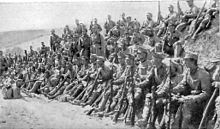Battle of Krasnik - Picture
More about World War 1

|
|
Battle of Krasnik
Date
August 23-25, 1914
Location
Krasnik, Congress Poland, Russian Empire (present-day Poland)
Result
Austro-Hungarian victory
Date: August 23-25, 1914
Location: Krasnik, Congress Poland, Russian Empire (present-day Poland)
Result: Austro-Hungarian victory
Belligerents:
: Austria-Hungary
Commanders and leaders:
: Conrad von Hx¶tzendorf
Viktor Dankl
Strength:
: I. Army
144 infantry battalions
71 cavalry squadrons
354 guns
Casualties and losses:
: 15,000
Vistula River - Limanowa - Bolimx³w - 2nd Masurian Lakes - Gorlice-Tarnx³w - Great Retreat - Sventiany Offensive - Lake Naroch - Brusilov Offensive - Kowel - Kerensky Offensive - Operation Albion
The Battle of Krasnik started on August 23, 1914 in the province of Galicia and the adjacent areas across the border in the Russian Empire, in northern Austria (now in present day Poland), and ended two days later. The Austro-Hungarian First Army defeated the Russian Fourth Army. It was the first victory by Austria-Hungary in World War I. As a result the First Army's commander, General Viktor Dankl, was (briefly) lauded as a national hero for his success. The battle was also the first of a series of engagements between Austria-Hungary and Russia all along the Galicia front.
Initial deployment
The battle took place soon after the commencement of hostilities on the Eastern Front. In the East, late August and early September 1914 were characterized by a series of small-scale engagements between the Central Powers, Austria-Hungary and Germany, and the Allies, Serbia and Russia. Both sides rushed to mobilize their armies and thrust them headlong toward their frontiers in order to secure their borders and advance upon enemy territory as early as possible. Most of the early clashes tended to result in Russian and Serbian victories. By August 23, Russian forces had penetrated fifty miles into Prussia. Austria-Hungary had made minimal advances into Russian Poland by occupying Miechx³w, unopposed, on August 20.
During this early period the First Army was given orders issued by Austro-Hungarian Chief of Staff, Franz Graf Conrad von Hx¶tzendorf, to head toward Lublin and Brest-Litovsk in Russian Poland in order to make contact with the enemy and reach the strategic Warsaw-Kiev railroad. The First Army moved along the eastern bank of Vistula River and was to cross the San River, in the far northwest corner of Austro-Hungarian Empire. The First Army was accompanied by the Austro-Hungarian Fourth Army on its eastern flank. At the same time Russian commander Nikolai Ivanov had ordered the Russian Fourth and Fifth Armies to strike Austria-Hungary in the north. Dankl's First Army would make contact with Salza's Fourth Army at Krasnik while the Austro-Hungarian Fourth Army met the Russian Fifth in the Battle of Komarx³w. These maneuvers were to become part of a wider battle, the Battle of Galicia.

Picture - Austro-Hungarian troops rest during an advance.
Battle
Going into the battle of Krasnik, the Austro-Hungarian forces enjoyed two key advantages over their Russian opponents: superior numbers and a better strategic position. Dankl's First Army enjoyed a numerical advantage of ten and a half infantry and two cavalry divisions to Baron Salza's six and a half infantry and three and a half cavalry divisions. Chief of Staff Conrad's orders for the First Army further compounded Austro-Hungarian superiority by placing a larger than expected concentration of force further west than Ivanov and Russian Chief of Staff, General Alexeyev, had expected.On August 22, Alexeyev issued orders to his Fourth and Fifth Armies in an attempt to improve their position in the crash course they were now headed, aimed at a larger, flanking pair of armies. While these orders probably saved the Russian Fourth Army from a possible much worse defeat, it failed to change the nearly pre-ordained outcome of the battle. The battle raged for the following few days. The fighting was not characteristic of the trench warfare that would define the Western Front, and to a lesser extent the Eastern Front. Long term positions were never constructed since neither army was able to take the time to dig in. Instead the battle was more fluid and involved a great deal of cavalry fighting since both sides had five and a half divisions of horsemen.
Aftermath
Once routed the Russians began a retreat towards Lublin with the also defeated Fifth Russian Army which had lost at Komarx³w. The victorious Austro-Hungarian forces followed, inflicting further losses on the Russians. Dankl would in 1917 be honoured with the highly prestigious Commanders' Cross of the Military Order of Maria Theresa, which automatically conferred a barony upon him as Freiherr von Dankl; in 1918 he was further advanced to the title of count and took the title of Graf Dankl von Krasnik. His performance handed the Austro-Hungarian Empire its first victory in World War I. However his time as a national hero would be short-lived; Dankl would later be pressured to withdraw toward Krakx³w. Later in the war he would be stationed on the Italian front where he would serve with much less distinction. The battle of Krasnik had set off a chain reaction of engagements along the extensive Galicia front, including the action at Lemberg, in what would be referred to as the Battle of Galicia. Unlike the success enjoyed at Krasnik, the Austro-Hungarians would eventually cave to Russian forces in a series of defeats. By September 11 they were forced to vacate this corner of their empire for a more secure position further south and west, beyond the San River.
On a more individual level, the battle was not only a key moment in the career of Dankl but in that of an up and coming cavalry officer of Finnish aristocratic descent, Carl Gustaf Mannerheim. Mannherheim led the Separate Cavalry Brigade of the Guard, a unit attached to Salza's Russian Fourth Army. He was awarded with the Sword of St. George for his role at Krasnik and would later go on to be involved with the various other engagements in the Battle of Galicia.
More aircraft.
Source: WikiPedia